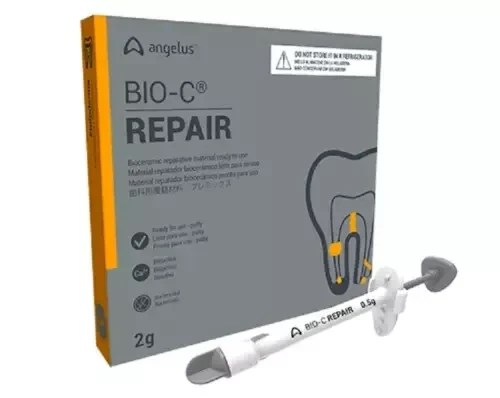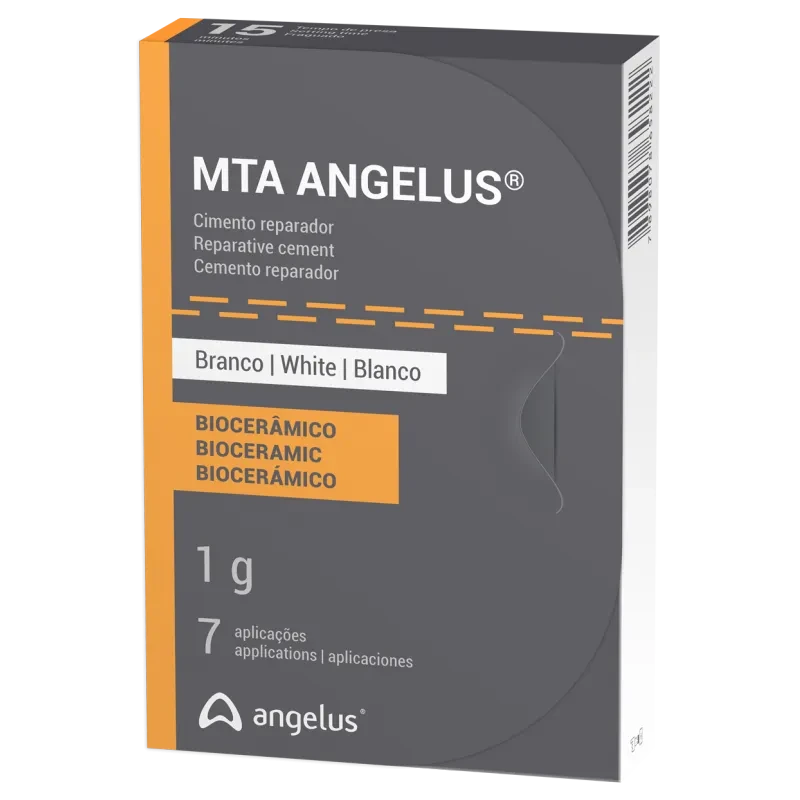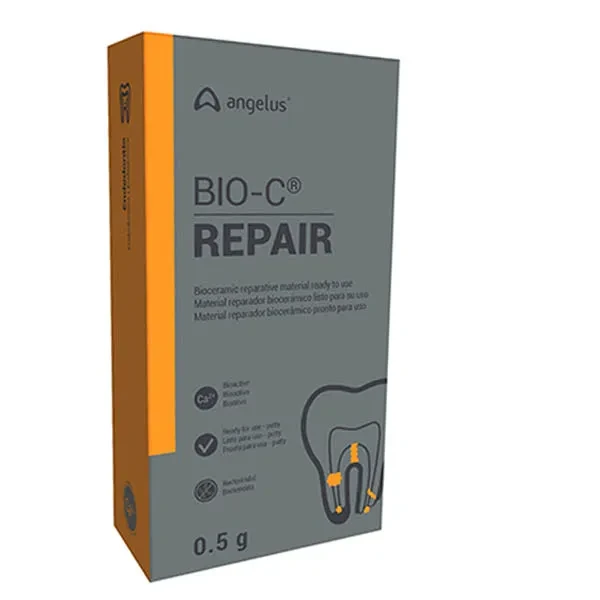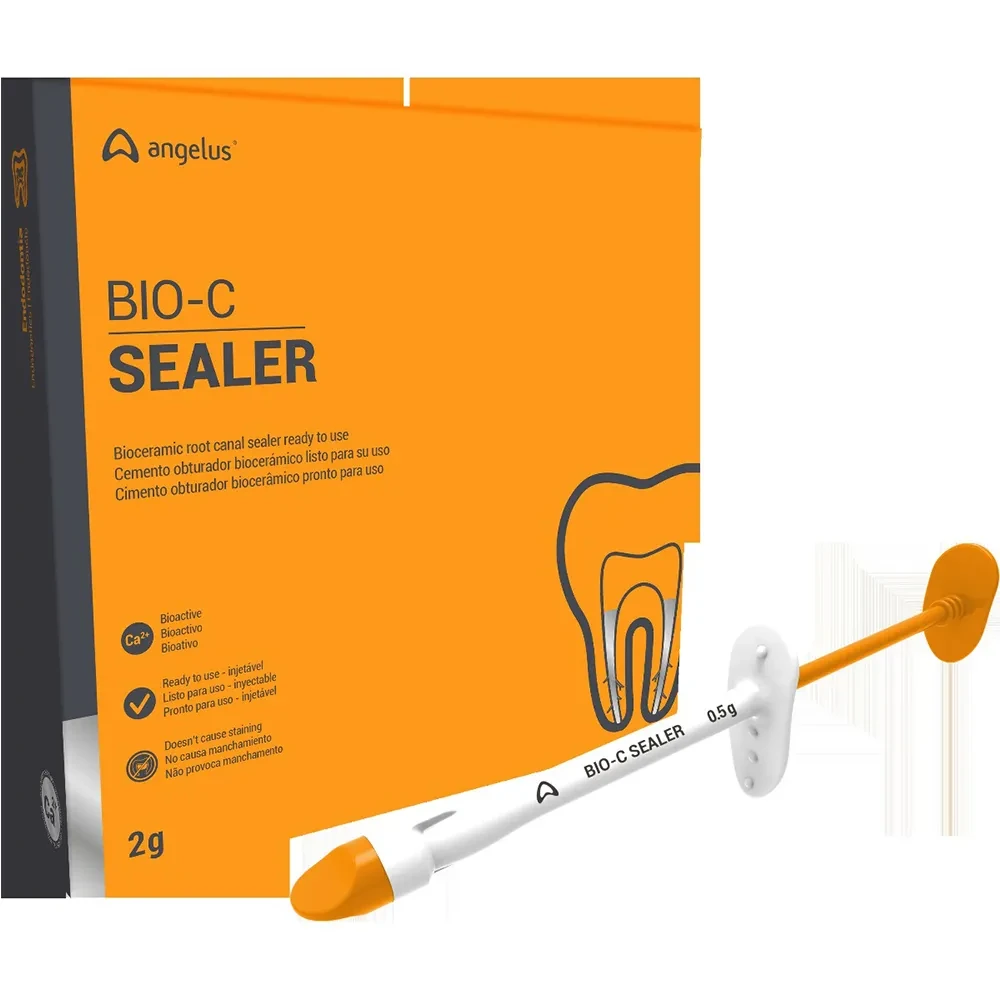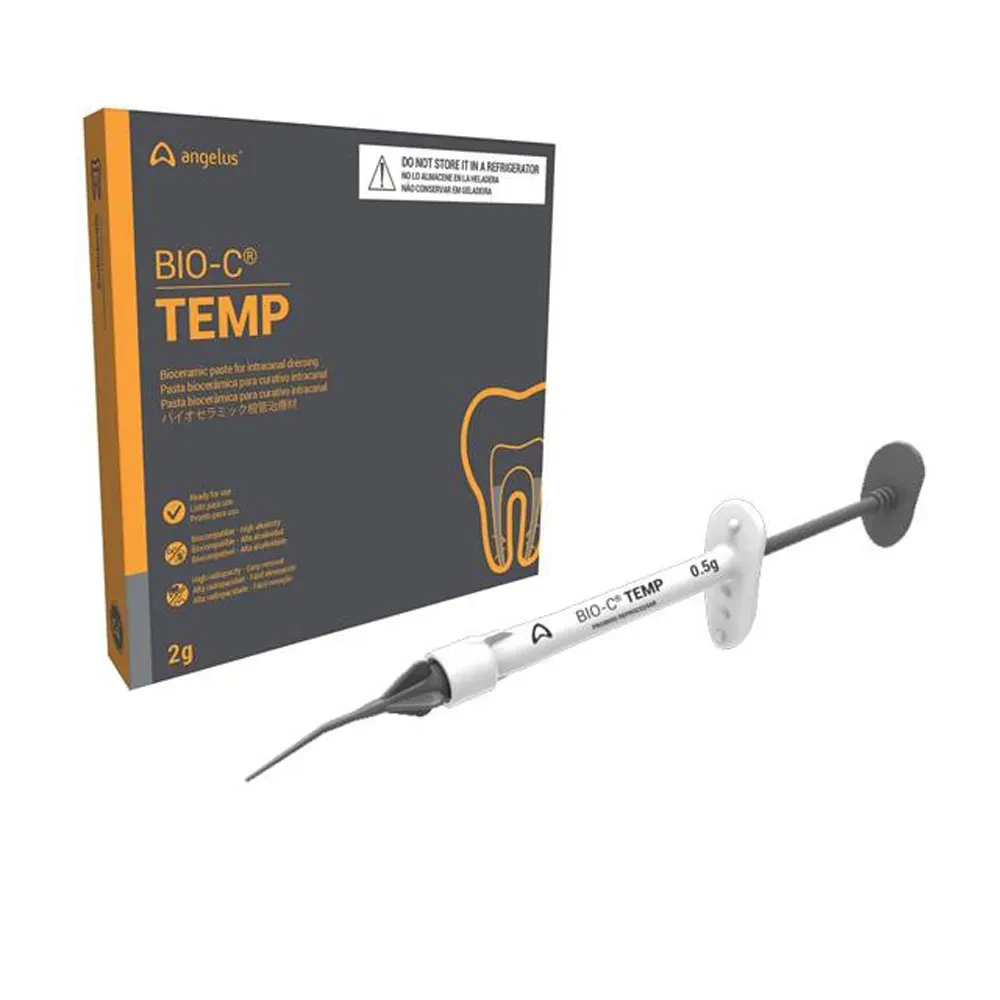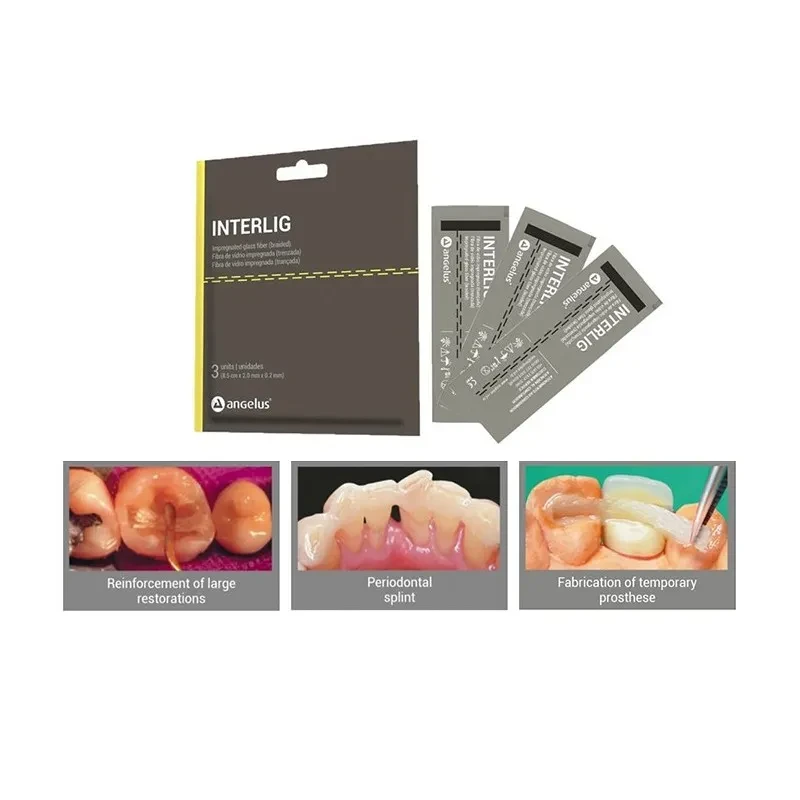
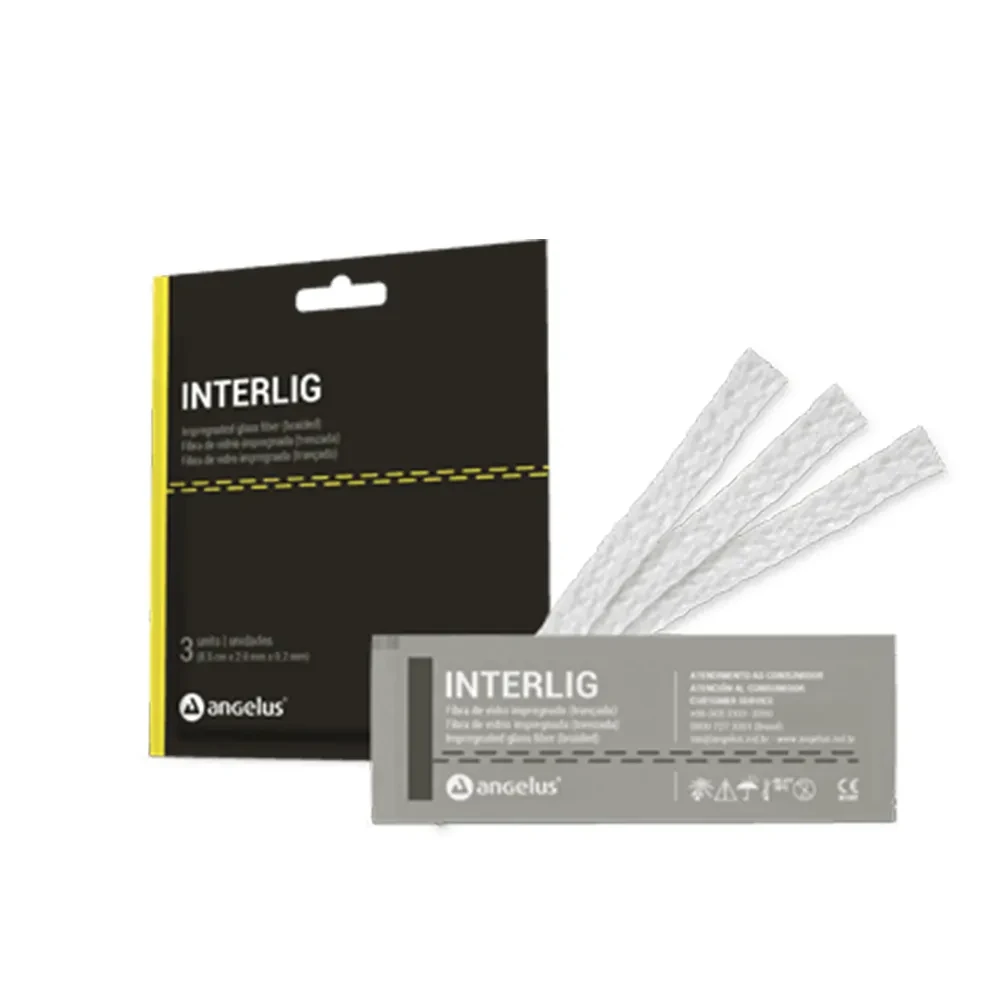


Angelus Interlig Single Patient Strip
-
$79.85
-
$133.08
-
$133.08
-
$23.75
-
$34.75
Reviews & Ratings
Angelus Interlig - Braided glass fiber impregnated with light-cured composite resin.
Interlig is a reinforced composite material with glass fibers, for use in the clinic, with a range of applications: temporary periodontal or orthodontic immobilization, for emergency treatment of teeth lost due to periodontitis, pre-surgical splinting, for the reinforcement structure of fi xed prosthesis, either mediate or immediate, for making intraradicular cores, for space retaining in primary or permanent dentition, for reinforcement of acrylic structure (provisional, total prostheses), for reinforcement of large restorations of composite resin.
Interlig glass fibers are intertwined, which facilitates the use by the dentist. Their maleability is superior than that of the polyethylene fibers.
Interlig can be cut with any cutting instrument, and does not require special equipment. The glass fibers are impregnated with light-cured composite resin, and for this reason, no other type of adhesive or resin is needed to impregnate them. Pre-impregnation facilitates handling and improves bonding between the glass fibers and the composite resin.
The fibers are pre-impregnated with an unfilled resin matrix, using an immersion process with controlled time and temperature, in order to guarantee complete absorption and, consequently, guaranteeing the better mechanical performance of the product.
Indications :
- Splinting in Periodontics, Orthodontics, and of avulsed or extracted
- Reinforcement of resin-retained fixed bridges (with natural or artificial teeth) and temporarily fixed bridges made directly (in the dental office) or indirectly (in the lab)
- Reinforcement and repair of acrylic resin
- Fabrication of space retainers in pediatric dentistry
- Reinforcement of large restorations.
Features:
Aesthetics: the translucency of Interlig® fibers and of the resin matrix provides high
aesthetic resolution;
Strength: the structural composition of Interlig® fibers and their preparation for dental
use ensure their high resistance to bending, ensuring their indication for a wide range
of clinical situations;
Versatility of use: Interlig width can be adapted for use in various clinical activities;
Excellent bonding to composite resin: the pretreatment of the Interlig® fibers allows
for perfect adhesion to resins in use in the clinic;
Convenience of use: does not require special tools for cutting and comes already
impregnated with resin;
Reversible and minimally invasive technique: due to its adhesion to the adhesive and
resin systems, work done with Interlig® does not require invasion of the tooth structure;
Time-saving: work with Interlig can be performed directly in the mouth, allowing for
its completion in one session;
Low cost: compared to traditional techniques, using Interlig® allows you to perform
more attractive and durable work, with a better cost-benefit ratio;
Packaging in sachets: Interlig comes wrapped in special sachets providing easy
handling and protection of the fibers against the action of light and heat.
Key Specifications:
Fiber structure: Intertwined scaffold
Optical: Translucent
Thickness: 0.2 mm
Width: 2 mm
Length: 8.5 cm
Polymerization time : 20 sec. per segment
Composition :
Glass fibers (weight) - 60 ± 5%.
Impregnated resin (weight) 40 ± 5%: Bis-GMA
Diurethane
Barium glass
Silicon dioxide
Catalysts
Packaging:
1 x Fiber (8.5 cm long)
Direction to Use:
TECHNIQUE FOR USE -:
A. PERIODONTAL SPLINT
Pre-op;
Isolate with a rubber dam (ideally) and place wedges interproximally to help controlling the flow of resin in these areas;
With a pencil, delineate the area for cutting a groove; (Cutting a groove is an optional procedure that depends on the clinical situation).
Make a 0.8 mm deep x 2.0 mm wide groove;
Etch with 37% phosphoric acid for 30 seconds; wash and dry (areas of exposed dentin should not be desiccated);
Apply the adhesive FUSION-DURALINK system (same procedures used for direct composite resin restorations);
Light-cure all segments of the splint site for 20 seconds each;
Fill half of the groove with a hybrid or micro hybrid composite resin (microfil resins should not be used in splinting);
Cut a section of INTERLIG slightly shorter than the length of the groove; position INTERLIG® in the groove and press it towards the composite resin;
Gently pressing, light-cure each segment of the splint for 20 seconds; curing of non-pressed areas should be avoided by covering them with an aluminum foil;
Apply a second layer of composite resin to cover the groove totally; the resin must also be placed slightly beyond the limits of the groove;
Light-cure each segment for 40 seconds;
Remove the excess of resin, check the occlusion, and adjust it if necessary; proceed with finishing and polishing;
Apply a final layer of fluid resin (adhesive) to fill any irregularity or superficial bubbles and voids; light-cure all segments for 20 seconds each;
B. DIRECT FIXED BRIDGE
Pre-op;
Mark the site where the root will be cut after the extraction;
Area after tooth removal;
Cut the root 1 to 2 mm apically to the mark considering soft tissue shrinkage during the healing process; shaping and polishing of the apical end of the tooth should produce a pontic-like, smooth, and ovate design;
Open the canal through the root, remove all pulpal tissue and fill the canal with composite resin (phosphoric acid and an adhesive system must be used);
Isolate with a rubber dam and cut a groove (0.8 mm deep x 2.0 mm wide) on the abutment teeth and on the extracted tooth;
Fix the extracted tooth on the desired site with a small amount of composite resin placed facially; do not acid-etch now because this composite resin will be removed later; light-cure the resin;
Acid-etch (37% phosphoric acid) for 30 seconds; wash and dry without desiccating any exposed dentin;
Apply the adhesive FUSION-DURALINK system, wait for 20 seconds, and remove the excess of bonding agent with a light stream of air; light-cure each segment for 20 seconds;
Apply a layer of a hybrid or micro hybrid composite resin filling half of the groove;
Measure and cut INTERLIG® with a scalpel or scissors in a slightly shorter size than the groove to facilitate insertion;
Place INTERLIG in the groove, press it, and light-cure each segment for 40 seconds; curing of non-pressed areas should be avoided by covering them with an aluminum foil;
Apply a new layer of composite resin to cover INTERLIG completely and fill the groove; the resin must be placed a little beyond the limits of the groove; light-cure for 40 seconds;
Remove excess resin, check the occlusion, and adjust it if necessary; proceed with finishing and polishing; apply a layer of fluid resin (adhesive) to fill any irregularity or superficial bubbles and voids; light-cure all segments for 20 seconds each;
Final result.
C. INDIRECT FIXED BRIDGE (FABRICATED ON A WORKING CAST)
In the mouth, prepare a groove (0.8 mm deep x 0 mm wide) on the abutment teeth and take the impression;
On the working cast, paint the groove and its adjacent areas with a thin layer of a release agent;
To be used as a pontic, select an acrylic resin denture tooth or make a tooth with a porcelain or composite resin;
Apply the adhesive FUSION-DURALINK system and light-cure for 20 seconds;
Insert a layer of light-cured hybrid or micro hybrid composite resin to fill half of the groove; do not cure;
Measure and cut INTERLIG with a scalpel or scissors in a slightly shorter size than the groove to facilitate insertion; place INTERLIG in the groove;
Press it and light-cure each segment for 40 seconds; curing of non-pressed areas should be avoided by covering them with an aluminum foil;
Apply a new layer of composite resin to cover INTERLIG completely and fill the groove; light-cure for 40 seconds;
With carbide burs or discs, trim the stone to release the bridge; the restoration should not be forced out of the working cast to avoid the risk of fracturing the connections; proceed with the final adjustments and polishing;
Bridge ready; it must be cemented with an adhesive technique (adhesive system and a composite resin or resin cement).
D. REINFORCEMENT OF TEMPORARY ACRYLIC RESIN BRIDGES
Cut an 8 mm deep x 2.0 mm wide lingual groove on the bridge;
Apply the adhesive FUSION-DURALINK system on the groove and light-cure for 20 seconds;
Measure and cut INTERLIG with a scalpel or scissors in a slightly shorter size than the groove to facilitate insertion;
Insert a layer of light-cured hybrid or micro hybrid composite resin to fill half of the groove; do not cure;
Place INTERLIG in the groove;
Press it and light-cure each segment for 40 seconds; curing of non-pressed areas should be avoided by covering them with an aluminum foil;
Apply a new layer of composite resin to cover INTERLIG completely and fill the groove; light-cure each segment for 40 seconds;
Proceed with the final adjustments and polishing;
Final result.
PRECAUTIONS -:
The components of INTERLIG may be allergenic. Avoid contact with oral tissues, skin & eyes. Use gloves, mask & eye protection. If accidental contact occurs, wash with water. If necessary, seek medical attention.
Keep it in a dry, cool place (below 28°C/ 82.4°F), protected from light, eugenol products, and excessive heat (furnaces, sterilizers).
Put the remaining fiber in the package immediately after use to avoid excessive exposure to environmental light.
WARNINGS -:
INTERLIG®must always be covered by the composite resin; any exposed fiber should be gently removed with burs and the area corrected with a new layer of composite
Structures reinforced with INTERLIG®should not create occlusal interferences; always check
Harmful habits (grinding, clenching, biting objects) should be corrected before indicating restorations reinforced with INTERLIG®.
Frequently Bought Products
Product Queries (0)
Login Or Registerto submit your questions to seller
Other Questions
No none asked to seller yet
-
$79.85
-
$133.08
-
$133.08
-
$23.75
-
$34.75
Dentistry Deal | DENTAL CARE PRODUCTS WITH GREAT DEALS
Finding good deals on dental care products can help you maintain oral hygiene without breaking the bank. Whether you're looking for toothpaste, floss, mouthwash, or even an electric toothbrush, there are several strategies you can use to save money:
1. Coupons and Discounts: Many dental care brands offer coupons either online or in newspapers and magazines. Websites dedicated to savings often have printable coupons or promo codes for online purchases.
2. Sales and Promotions: Keep an eye on local supermarkets, pharmacies, and big-box retailers for sales on dental products. These stores frequently offer discounts or "buy one, get one free" deals, especially during seasonal promotions.
3. Subscription Services: Some companies offer subscription services where dental care products are delivered regularly (monthly or quarterly). These subscriptions often come with a discount compared to buying products individually.
4. Bulk Purchases: Buying dental products in bulk can often reduce the cost per unit. Warehouse stores or online retailers may offer significant discounts for buying larger quantities.
5. Rebates: Occasionally, manufacturers offer rebates on dental care products. After purchasing, you can submit a rebate form along with proof of purchase to receive money back.
6. Store Loyalty Programs: Signing up for loyalty programs at your favorite stores can earn you points or discounts on future purchases, including dental care items.
7. Online Shopping: Comparison shop online to find the best prices. Many online retailers offer lower prices than brick-and-mortar stores, and you can often find additional discounts through promo codes or sales.
8. Manufacturer Websites: Check the websites of dental care product manufacturers for special offers, promotions, or loyalty programs that can help you save money.
9. Cashback Offers: Some credit cards or cashback websites offer cashback rewards for purchases at certain retailers or on specific categories, including health and personal care items.
10. Generic Brands: Consider trying generic or store-brand dental care products, which are often cheaper than name-brand options but can be just as effective.
By combining these strategies, you can find excellent deals on dental care products without compromising on quality. Regularly checking for discounts and promotions ensures that you can maintain your oral health regimen affordably.
When looking for dental care products, it's important to choose ones that are manufactured by FDA-approved companies. The FDA (Food and Drug Administration) regulates dental care products to ensure they are safe and effective for consumer use. Here are a few key points to consider:
FDA Approval: Ensure that the dental care products you purchase are approved by the FDA. This approval indicates that the product has undergone rigorous testing and meets safety and efficacy standards set by the FDA.
Reputation of the Company: Look for products from reputable companies that have a history of producing quality dental care items. Established brands often prioritize safety and efficacy in their products.
Product Labels: Check the product labels for information such as FDA registration numbers, ingredient lists, and usage instructions. Legitimate products will have clear and accurate labeling.
Reviews and Recommendations: Read reviews from other consumers and dental professionals to get insights into the effectiveness and safety of the products. Reliable reviews can help you make informed decisions.
Dental Professional Recommendations: Consult your dentist or dental hygienist for recommendations on FDA-approved dental care products that suit your specific oral health needs.
Avoid Counterfeit Products: Be cautious of purchasing dental care products from unauthorized sellers or sources. Counterfeit products may not meet FDA standards and could potentially be harmful.
Online Purchases: If purchasing online, buy from reputable websites and official manufacturer's sites to reduce the risk of receiving counterfeit or substandard products.
Check for Recalls: Periodically check FDA announcements or recalls related to dental care products to stay informed about any safety concerns or issues.
By choosing dental care products from FDA-approved companies, you can feel confident that you're using products that meet stringent safety and efficacy standards. Prioritizing quality and safety in your oral care routine contributes to maintaining good oral health over the long term.

